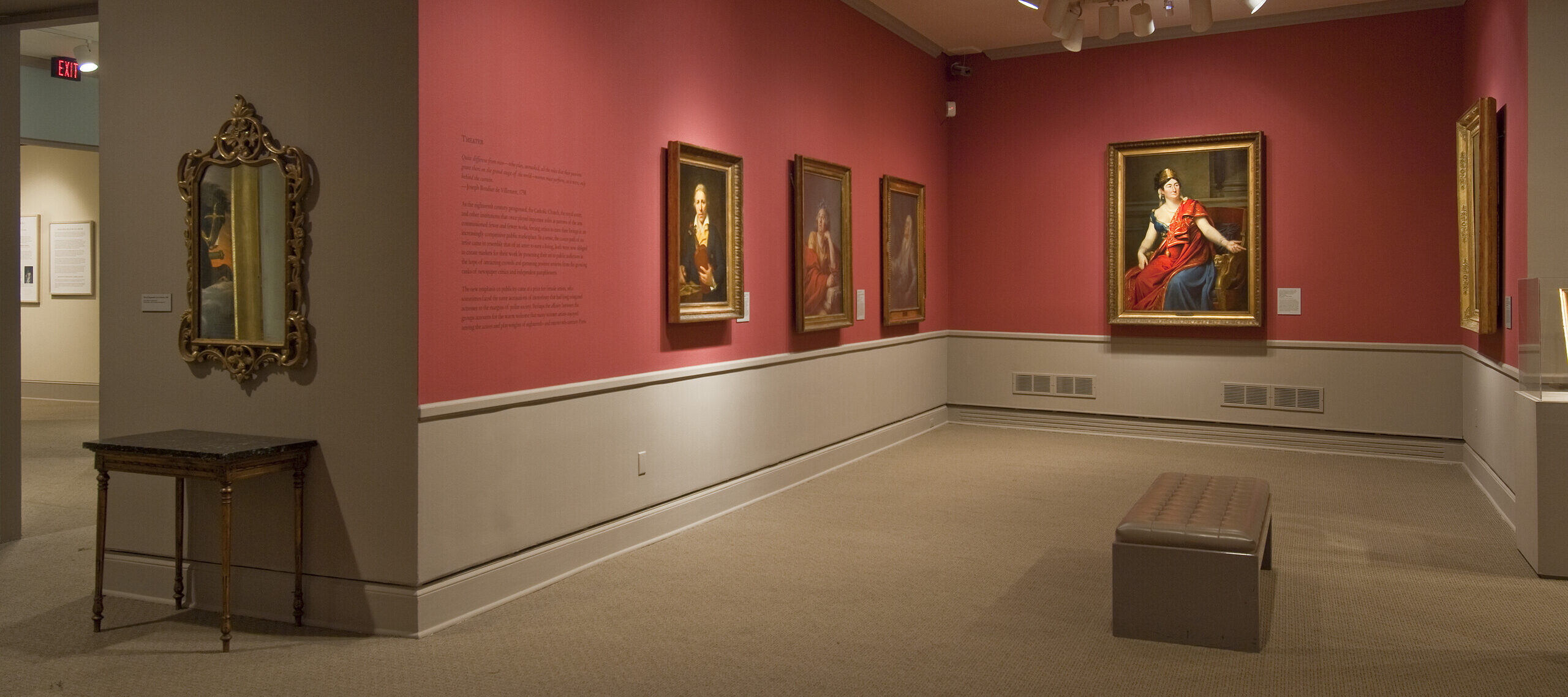In Royalists to Romantics: Women Artists from the Louvre, Versailles, and Other French National Collections, 77 works by 35 artists display the talents of French Revolution-era women artists. Their paintings are windows into their careers and the singular challenges of their time. The catalogue that NMWA has published to illustrate Royalists to Romantics includes essays as well as individual artist biographies that give insight into the lives of women artists working in France between 1750 and 1848. This excerpt explores the life of one the show’s featured artists, Constance Marie Charpentier.

Constance Marie Charpentier exhibited at least thirty works at the Paris Salons from 1795 to 1819, yet she is remembered almost exclusively as the painter of Melancholy (1801), included in the present exhibition.¹ Sound information about her training is scant; lists of her teachers traditionally include the history painters Jacques-Louis David (1748-1825) and Francois Gerard (1770-1837), as well as Louis Lafitte (1770-1828), who is best known for his decorative work, and the painter and engraver Pierre Bouillon (1776-1831).² A final name is variously given as that of the printmaker Johan-Georg Wille (1715-1808) or his son, the painter and sculptor Pierre-Alexandre Wille (1748-1821), or an artist identified only as Wilk.
Charpentier’s family history is better documented. In the year of her birth, her father, a Parisian merchant named Pierre-Alexandre- Hyacinthe Blondelu, was taken to court by the apothecaries’ guild for abrogating its privilege to formulate and sell medication.³ In 1793 the artist married Victor-Francois Charpentier, a government employee who worked for the prefecture of Paris and department of the Seine. Her husband’s brother-in-law, the Revolution’s fiery orator Georges Danton (1759–1794), sat for a portrait by Charpentier.
Charpentier met with considerable success at the Salons, where she exhibited primarily portraits and domestic genre scenes. In 1798 her pendant paintings Widow of a Day and Widow of a Year earned a prix d’encouragement, a commission for a painting to be purchased by the state for 1,500 francs. Melancholy, Charpentier’s only known history painting, fulfilled this commission, and its appearance at the 1801 Salon prompted an admiring poet to declare: “this painting lets us discover / Charm in melancholy.”⁴ Charpentier went on to win a gold medal at the Paris Salon of 1814, and a silver medal at the 1821 Salon exhibition at Douai, in northern France. Although she ceased exhibiting after 1821, she was still teaching ten years later when a dictionary of artists announced that she “receives, three times a week, young women who wish to follow her advice on drawing and painting” at her residence on the rue du Pot de fer Saint-Sulpice (part of the modern-day rue Bonaparte, in the sixth arrondissement of Paris).⁵
Notes
1. Thirty is the number given by Valerie Mainz, “Charpentier, Constance,” in Dictionary of Women Artists, ed. Delia Gaze (London, 1997), vol. 1, pp. 381 – 82.
2. See, for instance, E. Benezit, Dictionary of Artists (Paris, 2006), vol. 3, p. 807; French Painting, 1774–1830: The Age of Revolution, exh. cat. (Detroit, 1975), pp. 345–47; Charles Gabet, Dictionnaire des artistes de l’école française, au xixE siècle (Paris, 1831), pp. 132 – 33; Ann Sutherland Harris and Linda Nochlin, Women Artists, 1550–1950, exh. cat. (New York, 1976), p. 207; Jean-Francois Heim, Claire Beraud, and Philippe Heim, Les salons de peinture de la Révolution française, 1789–1799 (Paris, 1989), p. 163; and Margaret A. Oppenheimer, “Women Artists inParis, 1791–1814” (PhD diss., New York University, 1996), pp. 136–37. Except where noted, this biography is based on Oppenheimer’s work.
3. Oppenheimer (“Women Artists,” p. 136) gives her parents’ names. The lawsuit is documented in “Proces des maitres et gardes apothicaires contre Pierre Alexandre Hyacinthe Blondelu, pour preparation et vente de drogues,” 1767–68, Archives et manuscrits de la Bibliotheque interuniversitaire de pharmacie,Paris, ae/12.
4. Arlequin chasse du muséum par un artiste: Critique en prose et en vaudeville (Paris, [1801]), as translated and quoted in Matthieu Pinette, From the Sun King to the Royal Twilight: Painting in Eighteenth-Century France from the Musée de Picardie, Amiens, exh. cat. (New York, 2000), p. 177. Quoted in the original French, with citation, in Matthieu Pinette, Peintures françaises des xvii E et xviii E siècles des musées d’Amiens (Paris, 2006), pp. 252–53: “Et ce tableau nous fait trouver / Du charme a la melancolie.”
5. Gabet, Dictionnaire, pp. 132–33. Quotation from p. 133: “Mme Charpentier recoit, trois fois par semaines [sic], les jeunes personnes qui desirent suivre ses conseils pour le dessin et la peinture.”

